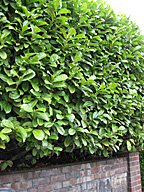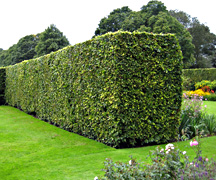Planting the Hedge
Selecting and Buying Hedging Plants
Having decided the species of plants for your hedge, you need to think about how you will buy them. Apart from some practical matters such as cost and how you will get them delivered, the two main choices you need to make are:
- Bare Rooted or Container Grown
Bare rooted-plants have been grown in the open field and are then dug up when they are sold in winter during the plant's dormant period. This is usually the cheapest way to buy plants but time is of the essence when you come to plant them since they could die if the roots are left exposed for too long. You should however try to avoid planting if the weather is excessively cold or wet.
Container-grown plants are no different when delivered to your plot than when on display at the nursery and therefore planting is not so time-critical. In fact, you should be able to purchase container-grown plants at almost any time of the year. However, they tend to be more expensive and you should try to avoid plants that have been left in the pots too long so that the roots are restricted. - Young or Mature
Whatever the intended purpose of your hedge, almost certainly you want to avoid all the growth being at the top with ugly gaps at the base. It is much easier to achieve uniform density throughout the height of the hedge if you start with younger, smaller plants. In addition, buying younger plants is cheaper.
The disadvantage of starting with young plants, of course, is that it will be longer before the hedge reaches its intended height. However, it is worth seeking advice about the particular species you are buying since the difference between younger and more mature plants may be only a couple of years.
You need to estimate the number of plants required. There is no hard and fast rule for deciding the distance between plants since this various according the species you have chosen and, to a limited extent, according to how thick you want the hedge to be. The best advice is to speak with a knowledgeable person at the nursery where you buy your plants.
Putting the Plants in the Ground

With all the preparation done and the plants delivered, it is time to put them into the ground.
Roughly position the plants along the trench at the correct intervals. This depends on the particular species of hedge you are planting but, in absence of any better advice, 18 inches to 2 feet may be about right - the more vigorous the nature of the plants, the greater the distance between them.
For a more substantial hedge, you may decide to plant a double row. In this case, the two rows need to be approximately 18 inches apart with plants inserted in a staggered manner. Within each row, the distance between adjacent plants needs to be increased to perhaps 3 feet.
Check the height is correct so that the soil will cover the portion of the roots and stem that were underground when the plants were growing at the nursery. Before putting the soil back it is important that the roots of each plant are well spread out.
Spade soil around each plant and then use your heel to firm the soil into place and ensure there are no air pockets.
When the planting is complete, it is a good idea to give the whole hedge a thorough watering. After all, the plants have just experienced a traumatic change, so the more you can do to make them feel at home the better.
Caring for a New Hedge

Immediately after planting, some hedges need to be trimmed. The purpose of this is to encourage more shoots to develop at lower levels by cutting back the lead shoots. Not all plants need this kind of treatment so again it is worth asking advice from the place where you buy your plants.
Thereafter, the major hazard in the first couple of growing seasons is that the plants may dry out. It is important, therefore, to ensure they have enough water, particularly during any periods of light or no rainfall.
Also ensure the plants have sufficient nutrients during their early years of growth by applying a general-purpose fertilizer.
If the site is prone to strong winds, it may be necessary to provide some form of protection until the plants have really established themselves. This might be in the form of some temporary fencing perhaps or it may be possible to park up a vehicle or two to take the force out of the wind.
Read more about Hedges |
Read more about Plants |
